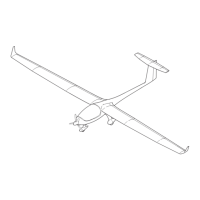FLIGHT MANUAL TSA-M, VARIANT S6
Doc.-No.:P400-006.000 E Page: 4-8 Revision: 10
Date of Issue: 07. October 2008 Agency approved Date of Rev.: 06.07.2020
4.4 Fueling of the Aircraft ____________________________
Fuel is filled into the wing-tanks through the filler-caps in the outer area of the
inner-wing-section (right side = main-tank, left side = optional auxiliary-tank).
Open the filler-caps by pushing and turning the slotted-screw in a
counterclockwise-direction with a screwdriver. Close the filler-cap by pushing
the screw and turning it in a clockwise-direction. Check for correct position of the
gasket when re-installing the filler-cap!
Note: The fuel sensor is calibrated to RON 95. All other fuel types
and mixtures of fuel will cause a lower fuel level indication in
the tanks than actual. The real fuel level has to be
determined visually, optional by using a dip stick (see ch.
7.12.4.1), and compared to the indicated fuel level on the
display in the cockpit. The deviation has to be considered for
flight planning.
Note: The filling-holes end close to the upper-brim of the tanks.
Therefore the wings must be leveled when fueling and when
opening the filler-caps. This is to prevent fuel from leaking.
Note: Do not fill the tanks completely at high temperatures.
Otherwise fuel might leak from the fuel-tank-vents (at the
wing-joint) due to thermal-expansion.
Note: Check for correct grounding of the fueling-system! For
example, this can be done by grounding the exhaust-pipe.
Note: The wing’s finish can be damaged by contact with fuel.

